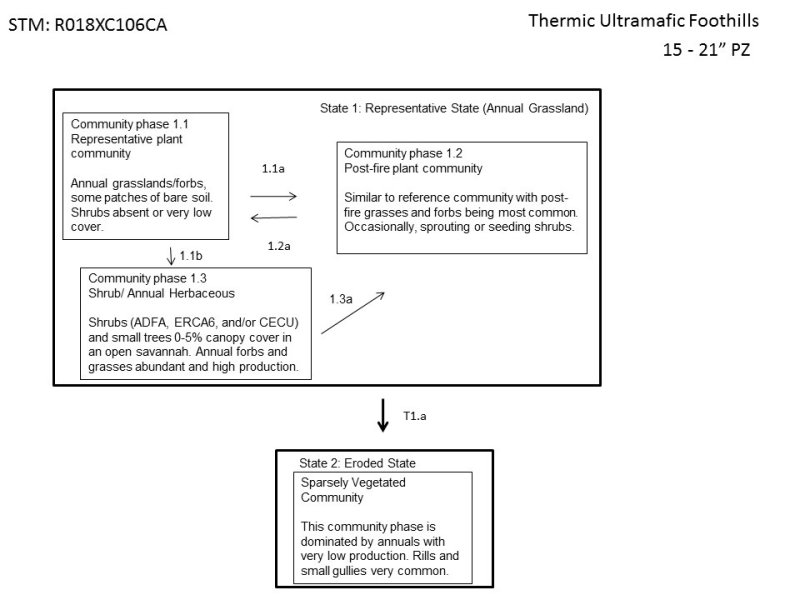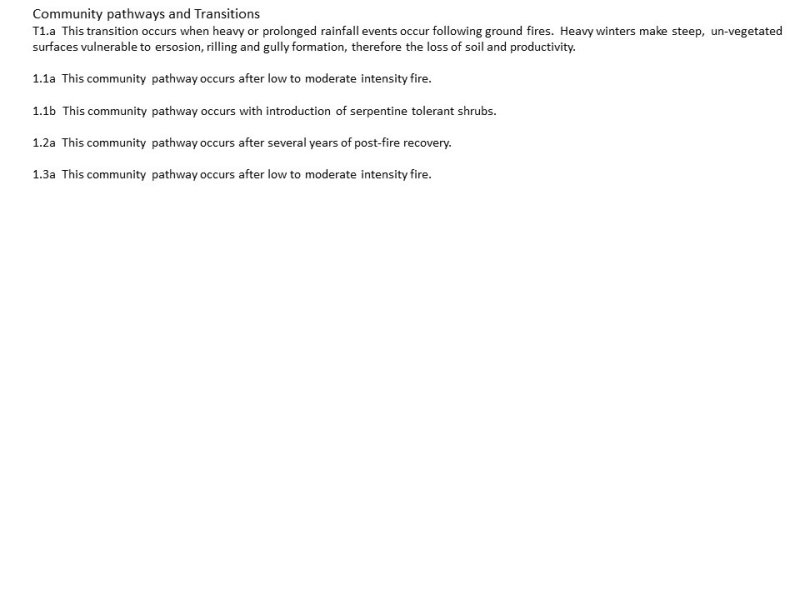
Natural Resources
Conservation Service
Ecological site R018XC106CA
Thermic Ultramafic Foothills
Last updated: 4/24/2024
Accessed: 12/06/2025
General information
Provisional. A provisional ecological site description has undergone quality control and quality assurance review. It contains a working state and transition model and enough information to identify the ecological site.
MLRA notes
Major Land Resource Area (MLRA): 018X–Sierra Nevada Foothills
Major Land Resource Area (MLRA): 018X–Sierra Nevada Foothills
Major Land Resource Area (MLRA) 18, Sierra Nevada Foothills is located entirely in California and runs north to south adjacent to and down-slope of the west side of the Sierra Nevada Mountains (MLRA 22A). MLRA 18 includes rolling to steep dissected hills and low mountains, with several very steep river valleys. Climate is distinctively Mediterranean (xeric soil moisture regime) with hot, dry summers, and relatively cool, wet winters. Most of the precipitation comes as rain; average annual precipitation ranges from 18 to 40 inches in most of the area (precipitation generally increases with elevation and from south to north). Geology is rather complex in this region; there were several volcanic flow and ashfall events, as well as tectonic uplift, during the past 25 million years that contributed to the current landscape. Due to extreme latitudinal differences in MLRA 18, Land Resource Units (LRUs) were designated to group the MLRA into similar land units.
LRU notes
LRU Description:
The Southern Sierra Foothills is defined by extensive granite (diorite, and other intrusive volcanic rocks) geology. Soil temperature regime is thermic (in most southerly and lower elevations, can be hyperthermic). Elevation ranges between about 500 and 3200 feet above sea level. Maximum elevations increase towards the southern end, where precipitation is considerably lower. Precipitation ranges from 14 to 32 inches annually. Most precipitation falls between the months of November and March in the form of rain. Mean annual air temperature ranges between 58 to 64 F. Frost free days range between 195 and 282 days. Dominant vegetation includes annual grasslands, blue oak, interior live oak, chamise (Adenostoma fasciculatum), buckbrush (Ceanothus cuneatus), and foothill pine. At the highest elevations of the LRU, canyon live oak (Quercus chrysolepis), Interior live oak, and California bay (Umbelullaria californica) can be found in the steep drainages. Chamise-yucca plant assemblages can be found on steep, south-facing slopes. Buckeye is common in the concave positions at lower elevations. Riparian trees that are generally absent from the northern LRU’s include California Sycamore (Plantanus racemosa) and lemon scented gum (Eucalyptus citriodora). Histories of livestock grazing and settlement due to mining activity have shaped the current landscape.
Classification relationships
CLASSIFICATION RELATIONSHIPS
This site is located within M261F, the Sierra Nevada Foothills Section, (McNab et al., 2007) of the National Hierarchical Framework of Ecological Units (Cleland et al., 1997), M261Fc, the Lower Granitic Foothills and M261Fd, Southern Granitic Foothills Subsections.
Level III and Level IV ecoregions systems (Omernik, 1987, and EPA, 2011) are: Level III, Central California Foothills and Coastal Mountains and Level IV, Ecoregion 6c, Southern Sierran Foothills.
Ecological site concept
This site is defined by soil formed from ultramafic bedrock on steep to very steep hills. These soils are characterized by low Ca:Mg ratios (generally < 2 in the subsurface horizons) and high heavy metal concentrations (Cr, Ni, Zn, Cu, Fe, Co, Cd). Slopes typically range from 40 to 60%. Precipitation is around 15 inches per year. Elevation ranges from 1650 to 2100 feet.
The overriding abiotic factor controlling this site is the serpentinite-derived, magnesic soils with low Ca:Mg ratios. These soils also have very high concentrations of heavy metals, which are toxic to many plants, causing stunted growth or reduced productivity. Generally, this site has strikingly different plant assemblages than adjacent, non-serpentinite sites. A secondary abiotic factor is the relatively low precipitation, in comparison to other ultramafic ecological sites in the Sierra Nevada Foothills. The low precipitation results in large areas with barren ground or very little vegetation. The most common soil components on this site are Fancher and Delpiedra. Fancher soils are moderately deep, well-drained soils developed in hydrothermally altered, ultramafic rock. They have relatively high Ca:Mg ratios compared to other ultramafic soils (1 to 2). They are classified as fine, magnesic, superactive, thermic Mollic Haploxeralfs. Delpiedra soils are also Mollic Haploxeralfs, only they are shallow and loamy and typically have lower Ca:Mg ratios (< 1).
Vegetation expression on soils formed in serpentinite varies from completely barren ground to chaparral (Lazarus et al., 2011) with altered species composition, depending on the chemical composition and degree of alteration of the parent material, and the climate and topography of affected soils. This site is dominated by chamise (Adenostoma fasciculatum), buckbrush (Ceanothus cuneatus), squirreltail (Elymus elymoides), soft chess (Bromus hordeaceus), and foxtail fescue (Festuca megalura).
Associated sites
| F018XC201CA |
Thermic Granitic Foothills This site commonly occurs nearby. |
|---|
Similar sites
| R018XI102CA |
Thermic Ultramafic Foothills Extremely High Magnesium Content (Ca:Mg Ratio Less Than 0.5) Site relationships being developed. |
|---|---|
| R018XI103CA |
Thermic Ultramafic Foothills Moderately High Magnesium Content (Ca:Mg Ratio 0.5 To 2) Site relationships being developed. |
Table 1. Dominant plant species
| Tree |
Not specified |
|---|---|
| Shrub |
(1) Ceanothus cuneatus |
| Herbaceous |
(1) Elymus elymoides |
Click on box and path labels to scroll to the respective text.
Ecosystem states
| T1.a | - | This transition occurs when heavy or prolonged rainfall events occur following ground fires. Heavy winters make steep, un-vegetated surfaces vulnerable to ersosion, rilling and gully formation, therefore the loss of soil and productivity. |
|---|
State 1 submodel, plant communities
| 1.1a | - | This community pathway occurs after low to moderate intensity fire. |
|---|---|---|
| 1.1b | - | This community pathway occurs with introduction of serpentine tolerant shrubs. |
| 1.2a | - | This community pathway occurs after several years of post-fire recovery. |
| 1.3a | - | This community pathway occurs after low to moderate intensity fire. |

